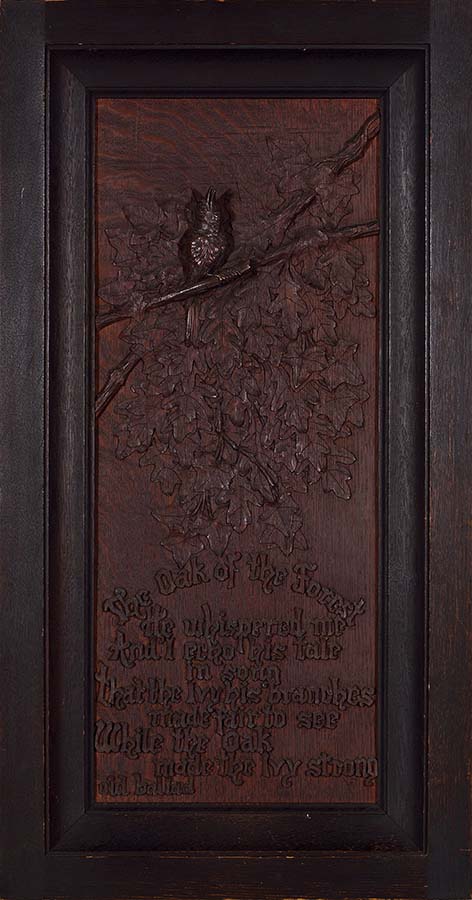William H. Fry
William H. Fry
The Oak and the Ivy
Carved Oak
27 x 11 inches
William H. Fry (1830-1929)
"[Henry Lindley] Fry left England for Cincinnati, arriving in the Queen City in 1851. His son, William H. Fry (1830–1929), whom Henry had taught, joined his father in Cincinnati around 1870. In the mid-nineteenth century, one of Cincinnati’s largest industries was furniture manufacturing, and the Frys quickly used that to their advantage. They set up their own business as carvers and designers of both furniture and architectural elements, both religious and secular.
The Frys soon began to receive commissions to decorate the interiors of the homes of some of Cincinnati’s most prominent citizens, including Henry Probasco (1820–1902) and Joseph Longworth (1813–1883). In the late 1850s Longworth hired the Frys to decorate his home, Rookwood, and the men created furniture specifically for the home. Longworth also hired the Frys to carve the interior of the home of his daughter, Maria Longworth (1849–1932) and her husband, George Ward Nichols (1831–1885). They worked on that project from 1868 to 1872.
As a result of the accolades the Frys received for their work in the Nichols’ home, they began to offer private classes in woodcarving in the early 1870s. Objects to be carved and decorated—whether a desk, a table, or a mantelpiece—were not constructed by the students. Instead, the piece of furniture was built and assembled by “joiners.” The furniture was disassembled and its component parts were then decorated by the students. After the carved decoration was complete, the parts were reassembled by the joiners.
With the start of the Frys’ private woodcarving classes, the Cincinnati art-carved furniture movement began. Another important figure in this movement was Benn Pitman (1822–1895). Under Pitman and the Frys, woodcarving was taught in Cincinnati for more than fifty years, and the work of their students gained national attention. The art-carved furniture movement in Cincinnati was based on the late nineteenth-century principles of the English Aesthetic Movement, which was a reaction to industrialization. The Aesthetic Movement and its proponents, including John Ruskin (1819–1900) and William Morris (1834–1896), advocated the creation of beautiful, unique objects that would, by their nature, elevate the decorative arts to a status equal to fine art and elevate the people using them.
The Frys’ woodcarving classes were taught in the city for over fifty years. When Henry died in 1895, William and his daughter, Laura Fry (1857–1943), continued teaching. However, after the turn of the century, interest in woodcarving declined. The end of the Cincinnati art-carved furniture movement came in 1926, when William taught his last class in woodcarving at the Art Academy of Cincinnati."
biography from "The Cincinnati Wing: The Story of Art in the Queen City" at cincinnatiartmuseum.org
